
Thrilled to see inventive new products in the ever-expanding universe of outdoor furniture, I, like any interior designer, have been seduced by creative, persuasive manufacturers who swear by the “carefree” longevity of their products and the “out of the box” materials they have chosen to fabricate their offerings.
“Except for death, there are no guarantees in life”—a familiar old chestnut that should be emblazoned on every outdoor furniture contract, because in the last five years, the widely popular fashion for outdoor living has peppered our world with furniture charlatans hawking construction materials, cushion stuffings and fabrics that everyone’s common sense tells them cannot withstand the continual brutality of outdoor use. The company catalogs and promotional materials showcase spotless, tailored pieces with gorgeous models lounging luxuriously alongside a pool, perched above the ocean—a fantasy fabrication that they should be tarred and feathered for.Yes, teak can be left outdoors for it will not rot—for a while. Once its natural oils have been zapped by unrelenting sun and exposure, and it turns that silver- gray color, it flakes and splinters and becomes fodder for paper-wasps. (I know, because some of my guests have been inconveniently stung by them.) Do not attempt to re-oil your teak unless you sand it down at least an eighth of an inch to the red, raw wood. This, of course, is tedious or costly or both. If you do not sand it down and you insist on oiling it, the teak will turn black—trust me. Many a client has tried, against my advice, and the teak appears to have been charred by a forest fire.
Yes, you may power-wash it, which eats into the pores of the wood, creating more splinters (which is why my guest bath hosts several tweezers), better fodder for the mud wasp, and an instant patina of “just-dredged-up-from-the-bottom-of-the-Titanic” look. Unable to quickly repurchase teak for a wedding I hosted, I desperately painted my teak with high-gloss outdoor Fine Paints of Europe paint. Miraculously, it has held through two winters. The jury is out, though, and I can’t really recommend this unorthodox approach. All I can say is that it looks good for now.
Iron furniture rusts and corrodes away. Paint it as often as you like, but I would suggest placing it in a remote part of your garden and growing some jackmanii clematis over it.
Ah, then there is the “new” stainless-steel furniture lacquered for longevity. Place it on a Palm Beach patio, hedged in by groomed ficus, and leave it to be dusted by West Palm Beach International Airport’s jet fuel acid rain—and lo and behold the lacquer burns off and the joints begin to rust.
And that cheerfully striped “custom for outdoor” fabric absorbs jet fuel dust like a sponge and then turns gray with professional cleaning. To prevent all of this, wipe off your furniture completely every day with a soft, damp cloth and place your cushions out only between the hours of 2:30 and 5:30 a.m. (not likely).
Chrome furniture, so excitingly retro chic, pits like the skin of an unsprung pomegranate. A white, corrosive, effervescent crust overtakes the metal unless it is washed daily. Once the spots appear, the pristine sheen is compromised and the chic chrome looks “retro worn.” Chrome outside is really not a good idea.
Recently, while visiting that dry desert oasis of Palm Springs, I was perturbed to see rust flourishing in the joints of fairly new painted metal poolside furniture—effectively defacing the clean lines of its stark, modern whiteness.
The loomed weaves of outdoor wicker have rotted for me on the decks of an oceanfront Sagaponack home, while my crimson, guaranteed-outdoor fabric faded to a shell pink (a color I rather like).
If one believes that white plastic outdoor furniture is the answer, one need only pass by the faded matte and yellowing fences hemming in our East End horse farms to surmise that longevity in polyvinyl chloride plastic is not a sure thing. Plastic sports a devil-may-care attitude when new, crisp and glossy, but as the East Hampton dump proves time and again, antique plastic, resins, PVC and fiberglass meet a dull, scratched, cracked and faded demise.
For outdoor use, plastic is terrific for seasonal party-animal watering holes that require “transient chic.” For longevity, keep your plastic inside.
Purveyors of outdoor furnishings are now pushing fully upholstered goods—stuffed with drip-through foam (woe to the ozone layer) and the new outdoor chenilles (mold) and bright, fade-resistant fabrics. Remember, “fade-resistant” is not “fade-proof. I give fully upholstered furniture on the shores of the East End about one season, and if one leaves it out all winter, I could pretty much bet that mildew and fading will take out the starchy freshness those glossy ads promise.
All outdoor furnishings and fabrics need care and maintenance, no matter what the manufacturer promises. All metals and metal alloys need the attention of wiping them down and cleaning them off, as you would your own car. Logic tells you that the East End’s salty, damp, windy, pollen-filled, ice-packed environment will deteriorate anything, including outdoor furnishings. So care must be taken.
Use common sense. Take your cushions in at night or when not in use and when it rains. Store your outdoor furniture indoors over the winter or at least buy waterproof covers if you must leave it outdoors for a time. Dust it and wipe it down as you would your regular furniture inside. Though many clients and customers believe that outdoor furniture has the half-life of plutonium, it doesn’t. And despite what the manufacturers advertise, unlike death, there are no guarantees in the life of outdoor furniture.
"